General, Sir John Monash, Personal Files Book 20, 31 July - 15 August - 1918 - Part 2
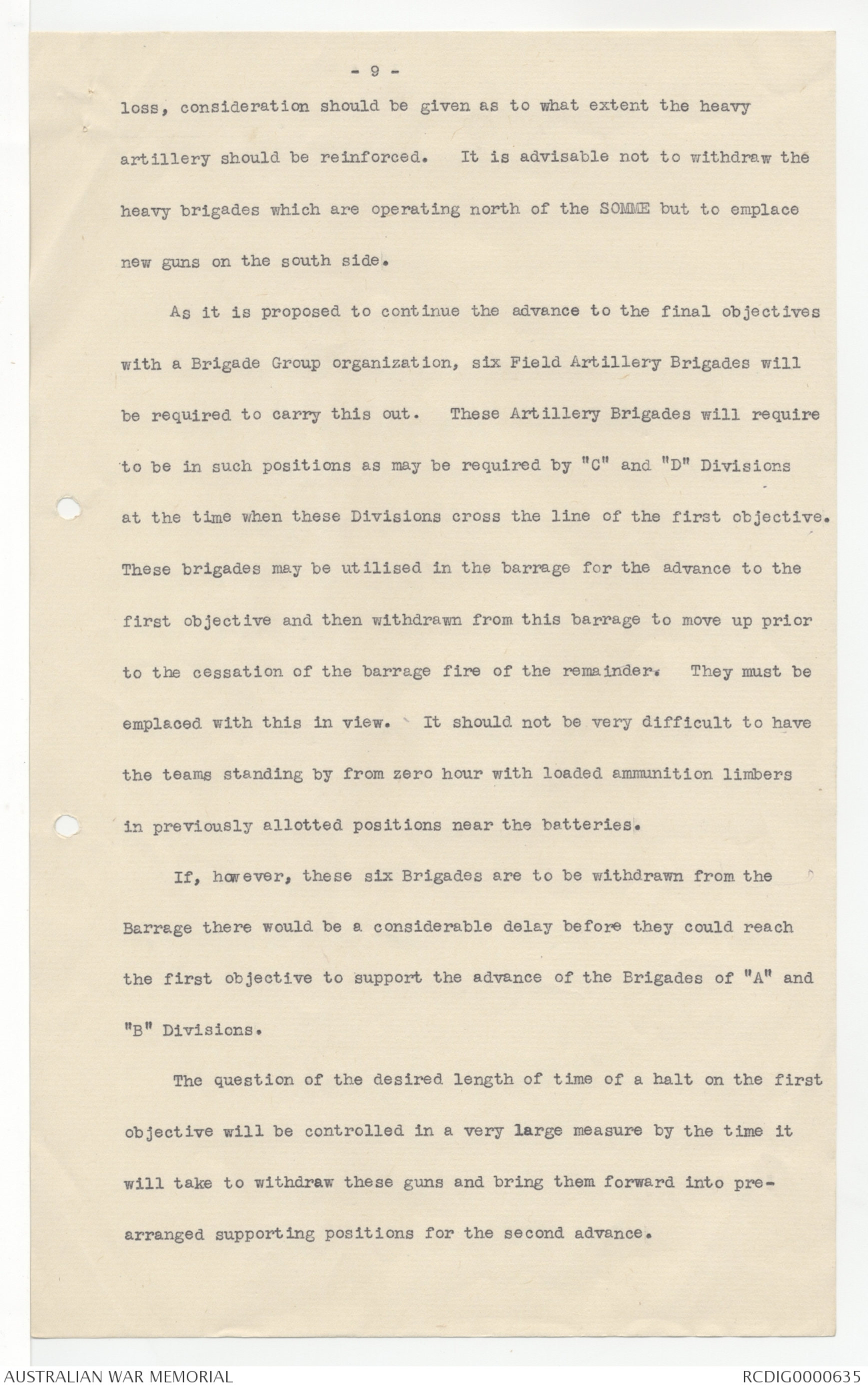
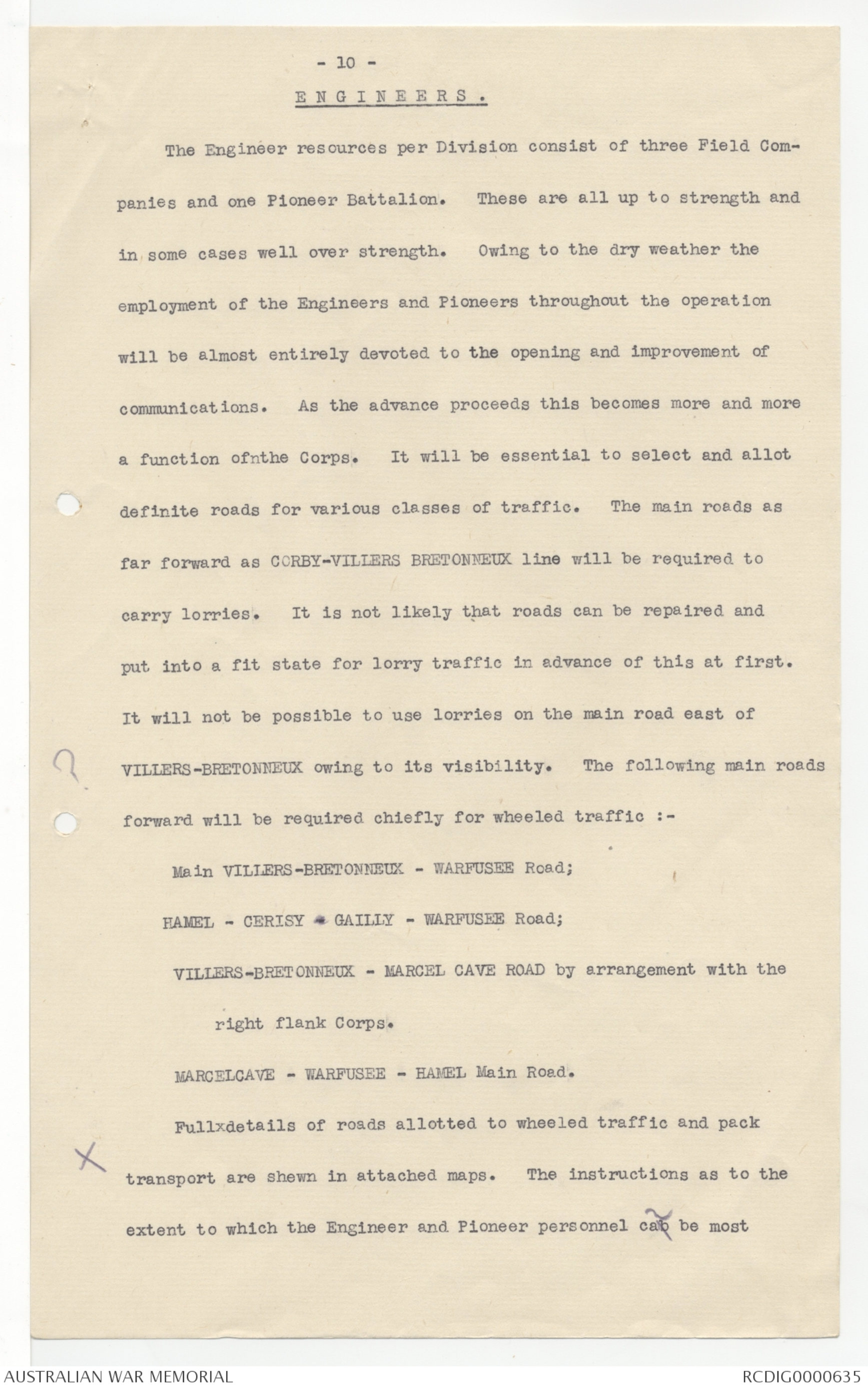
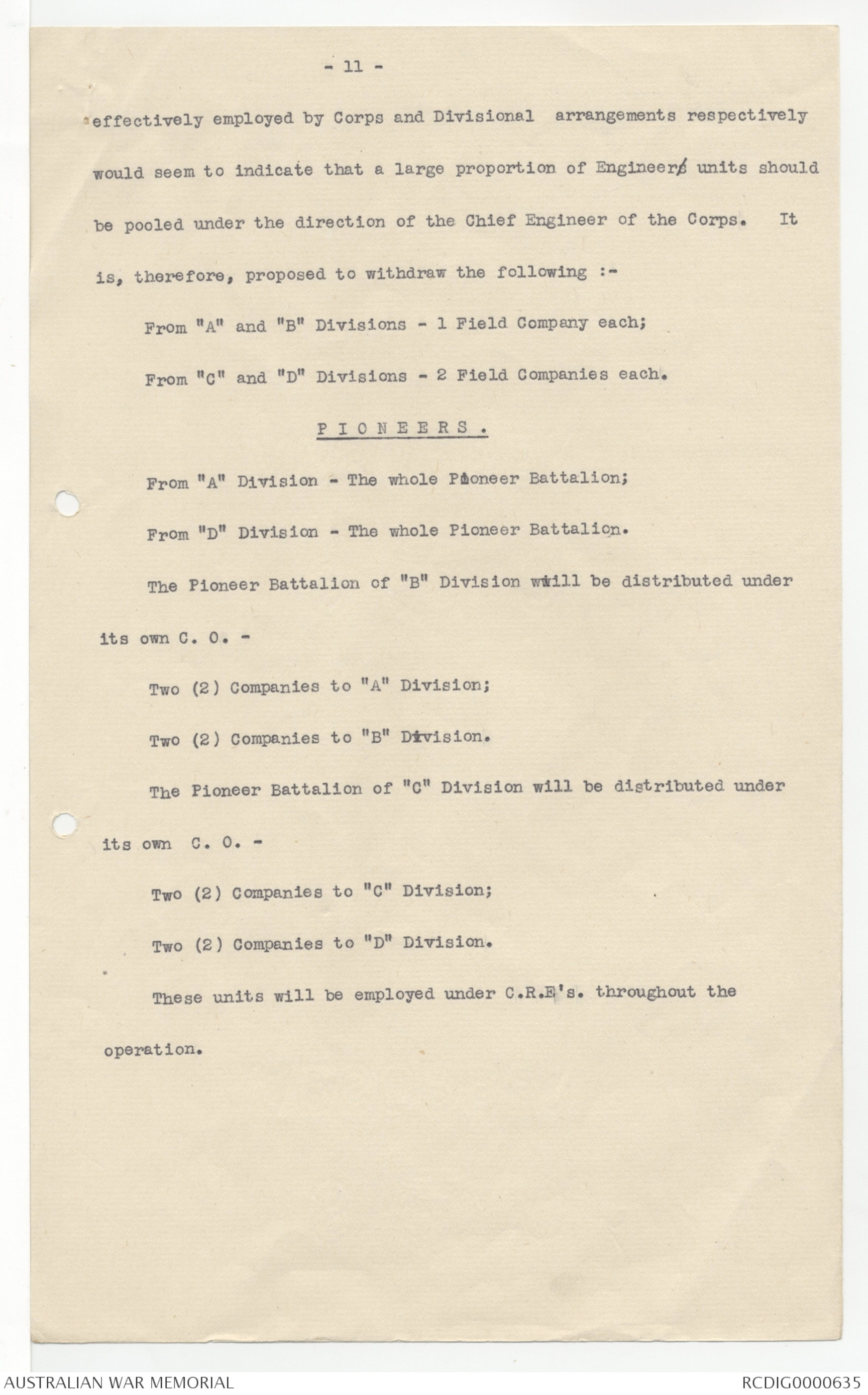
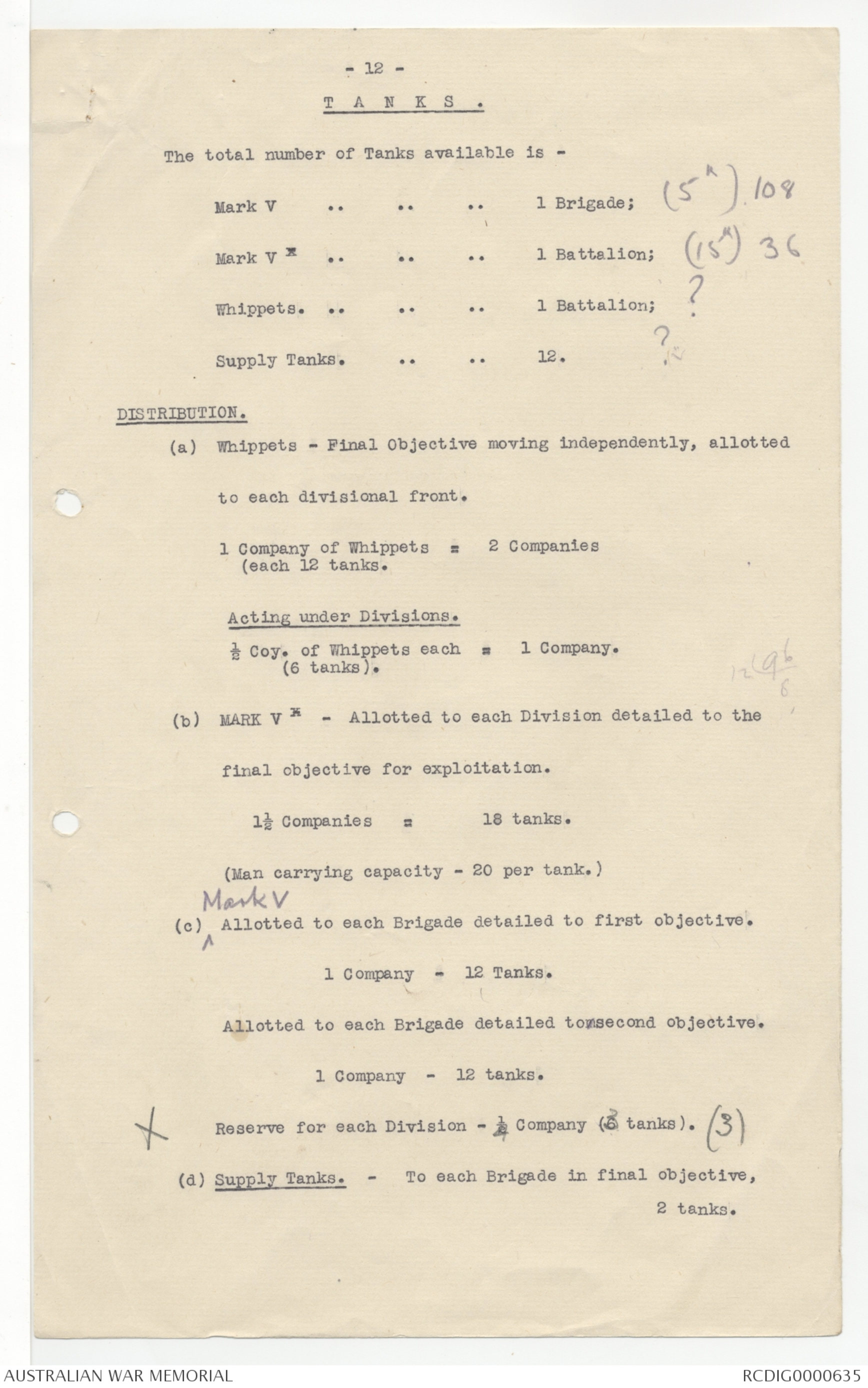
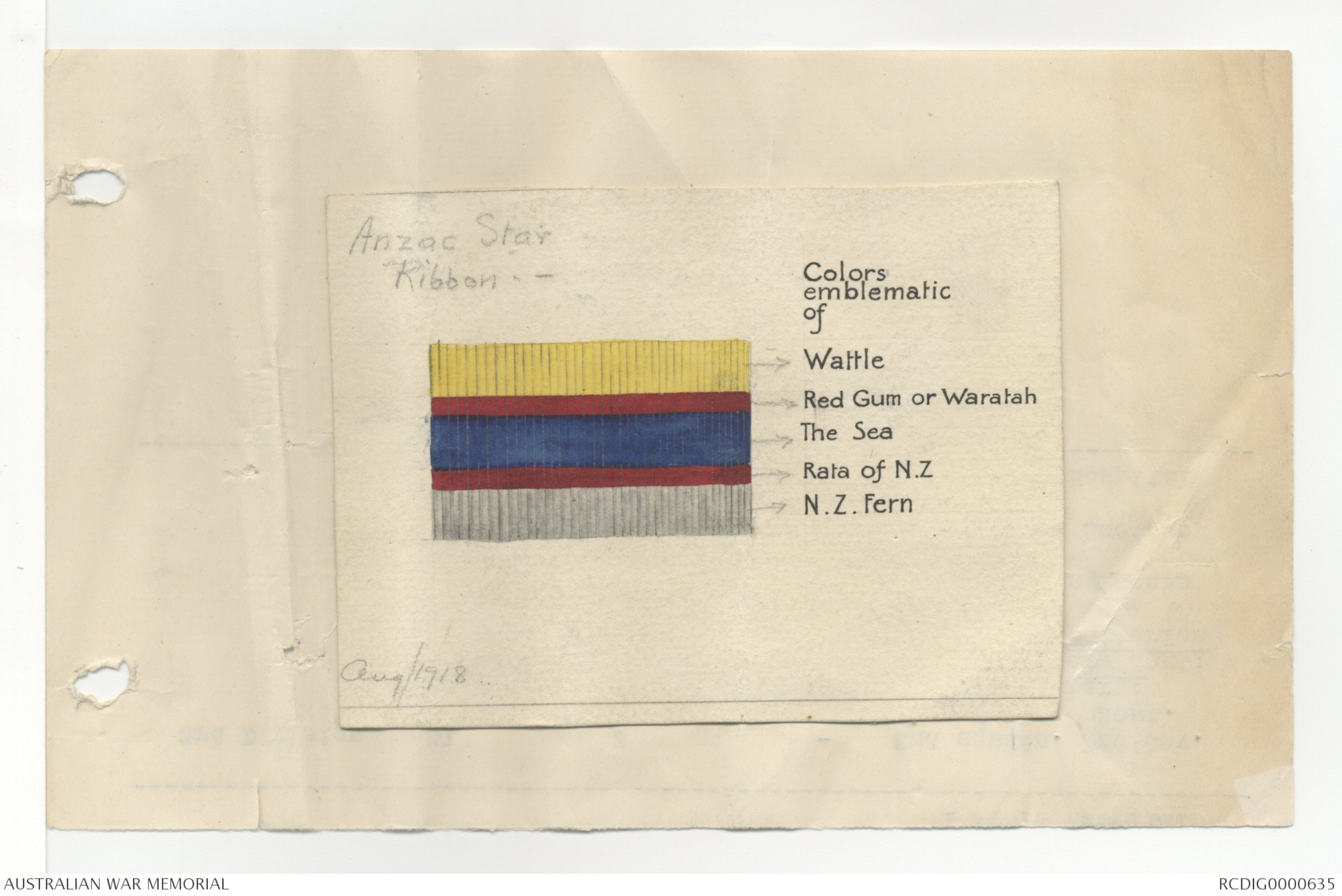
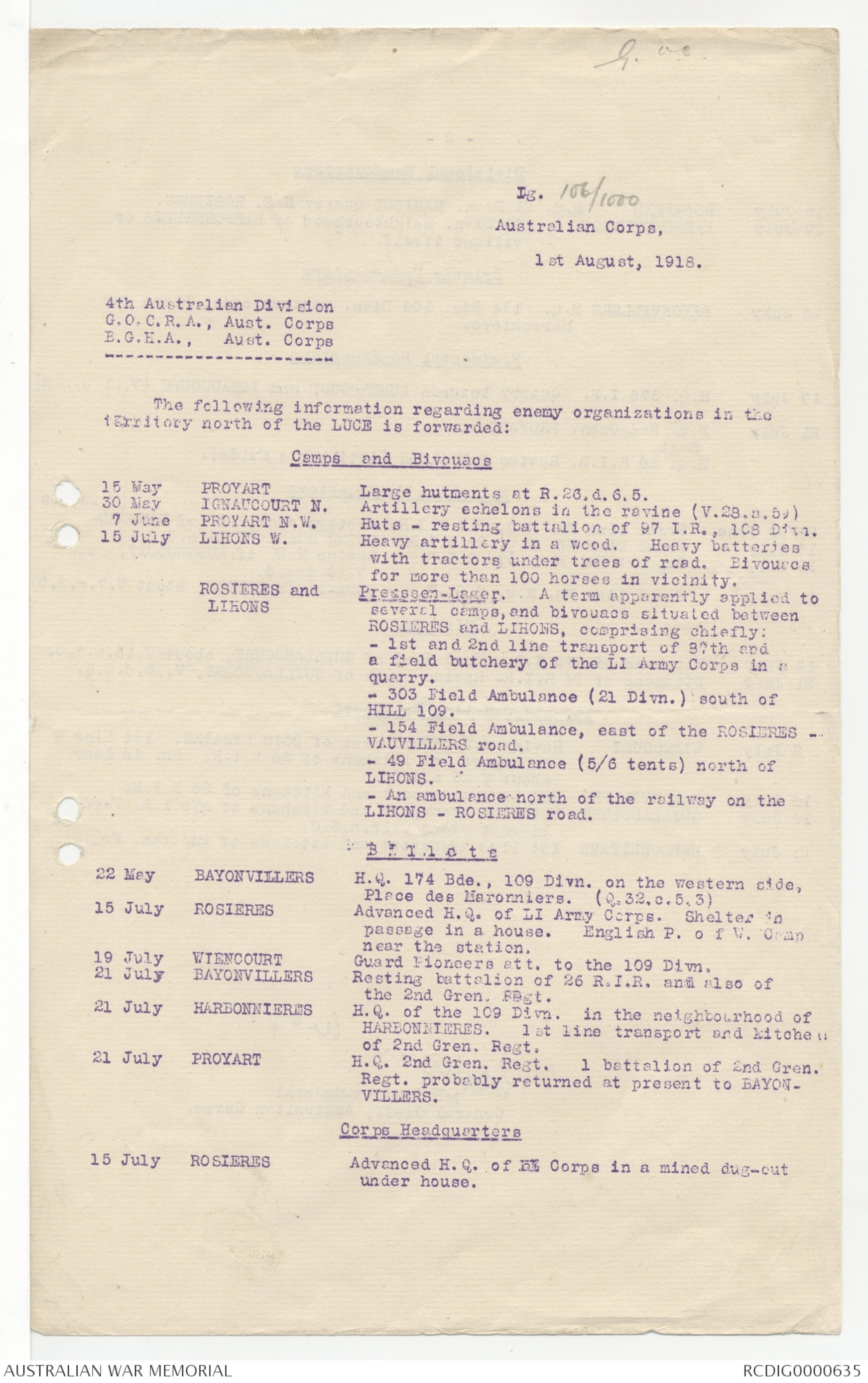
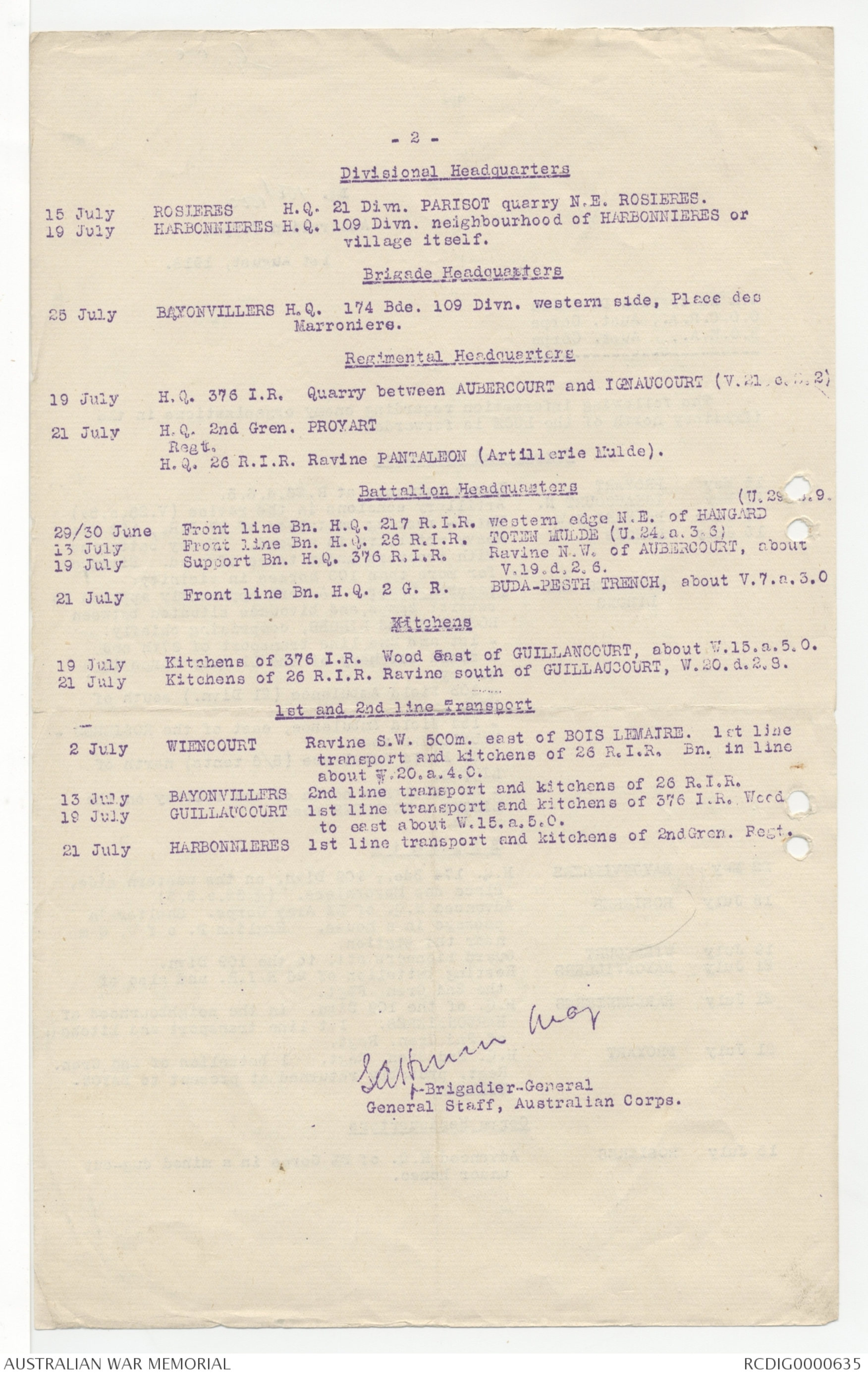
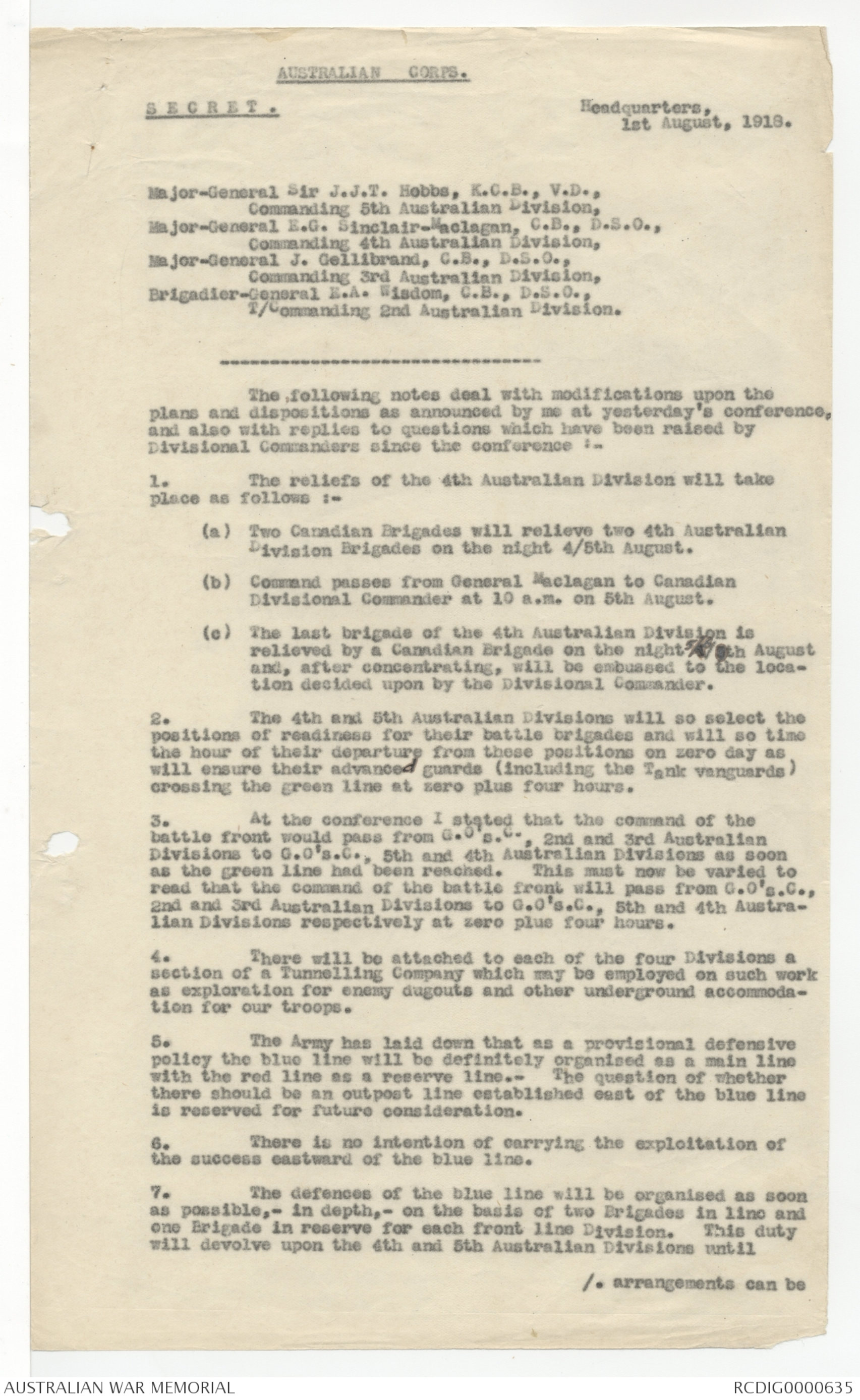
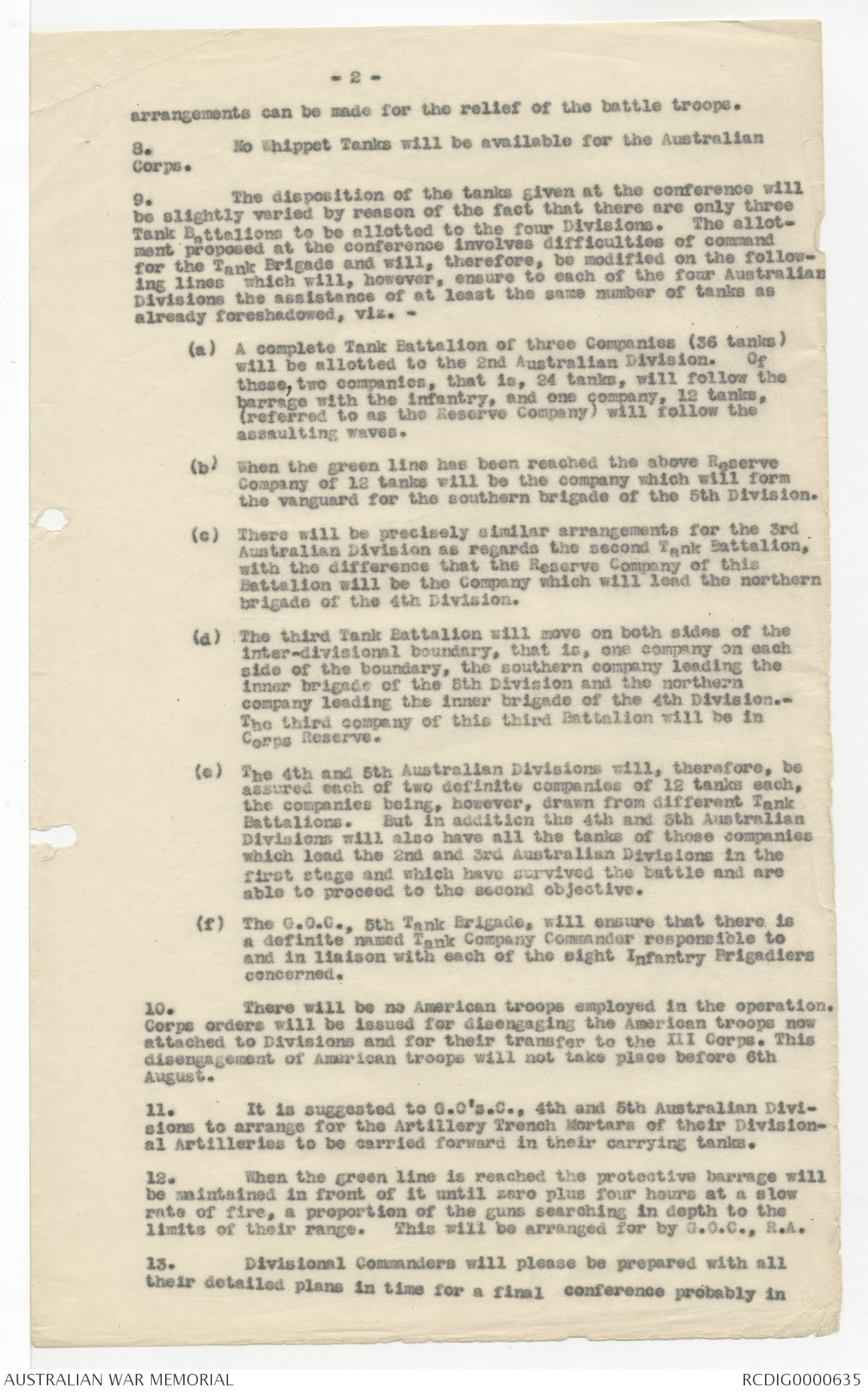
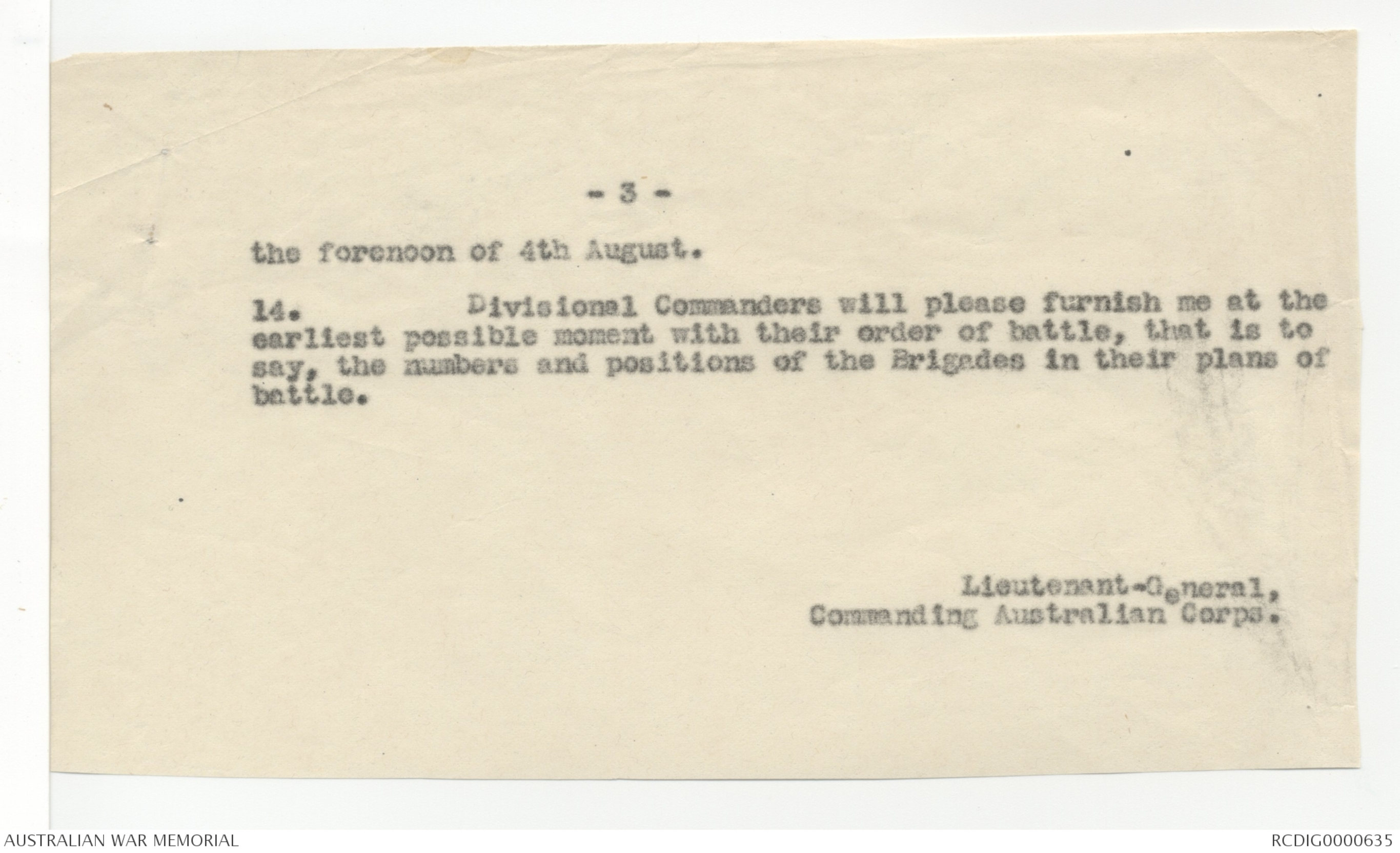
-9-
loss, consideration should be given as to what extent the heavy
artillery should be reinforced. It is advisable not to withdraw the
heavy brigades which are operating north of the SOMME but to emplace
new guns on the south side.
As it is proposed to continue the advance to the final objectives
with a Brigade Group organization, six Field Artillery Brigades will
be required to carry this out. These Artillery Brigades will require
to be in such positions as may be required by "C" and "D" Divisions
at the time when these Divisions cross the line of the first objective.
These brigades may be utilised in the barrage for the advance to the
first objective and then withdrawn from this barrage to move up prior
to the cessation of the barrage fire of the remainder. They must be
emplaced with this in view. It should not be very difficult to have
the teams standing by from zero hour with loaded ammunition limbers
in previously allotted positions near the batteries.
If, however, these six Brigades are to be withdrawn from the
Barrage there would be a considerable delay before they could reach
the first objective to support the advance of the Brigades of "A" and
"B" Divisions.
The question of the desired length of time of a halt on the first
objective will be controlled in a very large measure by the time it
will take to withdraw these guns and bring them forward into prearranged
supporting positions for the second advance.
- 10 -
ENGINEERS.
The Engineer resources per Division consist of three Field Companies
and one Pioneer Battalion. These are all up to strength and
in some cases well over strength. Owing to the dry weather the
employment of the Engineers and Pioneers throughout the operation
will be almost entirely devoted to the opening and improvement of
communications. As the advance proceeds this becomes more and more
a function ofnthe Corps. It will be essential to select and allot
definite roads for various classes of traffic. The main roads as
far forward as CORBY-VILLERS BRETONNEUX line will be required to
carry lorries. It is not likely that roads can be repaired and
put into a fit state for lorry traffic in advance of this at first.
It will not be possible to use lorries on the main road east of
[*?*] VILLERS-BRETONNEUX owing to its visibility. The following main roads
forward will be required chiefly for wheeled traffic :-
Main VILLERS-BRETONNEUX - WARFUSEE Road;
HAMEL - CERISY - GAILLY - WARFUSEE Road;
VILLERS-BRETONNEUX - MARCEL CAVE ROAD by arrangement with the
right flank Corps.
MARCELCAVE - WARFUSEE - HAMEL Main Road.
Fullxdetails of roads allotted to wheeled traffic and pack
[*x*] transport are shewn in attached maps. The instructions as to the
extent to which the Engineer and Pioneer personnel cabn be most
- 11 -
effectively employed by Corps and Divisional arrangements respectively
would seem to indicate that a large proportion of Engineers units should
be pooled under the direction of the Chief Engineer of the Corps. It
is, therefore, proposed to withdraw the following :-
From "A" and "B" Divisions - 1 Field Company each;
From "C" and "D" Divisions - 2 Field Companies each.
PIONEERS.
From "A" Division - The whole Pioneer Battalion;
From "D" Division - The whole Pioneer Battalion.
The Pioneer Battalion of "B" Division wwill be distributed under
its own C. O. -
Two (2) Companies to "A” Division;
Two (2) Companies to "B" Division.
The Pioneer Battalion of "C" Division will be distributed under
its own C. O. -
Two (2) Companies to "C" Division;
Two (2) Companies to "D" Division.
These units will be employed under C.R.E's. throughout the
operation.
- 12 -
TANKS.
The total number of Tanks available is -
Mark V .. .. .. 1 Brigade; [*(5th) 108*]
Mark V x .. .. .. 1 Battalion; [*(15th) 36*]
Whippets. .. .. .. 1 Battalion; [*?*]
Supply Tanks. .. .. 12. [*?*]
DISTRIBUTION.
(a) Whippets - Final Objective moving independently, allotted
to each divisional front.
1 Company of Whippets = 2 Companies
(each 12 tanks.
Acting under Divisions.
½ Coy. of Whippets each = 1 Company.
(6 tanks).
[*96/12 8*]
(b) MARK V x - Allotted to each Division detailed to the
final objective for exploitation.
1½ Companies = 18 tanks.
(Man carrying capacity - 20 per tank.)
(c) ^Mark V Allotted to each Brigade detailed to first objective.
1 Company - 12 Tanks.
Allotted to each Brigade detailed toxsecond objective.
1 Company - 12 tanks.
[*X*] Reserve for each Division - ½ ¼ Company (63 tanks). [*(3)*]
(d) Supply Tanks. - To each Brigade in final objective,
2 tanks.
Anzac Star
Ribbon -
Hand drawn drawing - see original document.
Colors
emblematic
of
Wattle
Red Gum or Waratah
The Sea
Rata of N.Z.
N.Z. Fern
[*Aug/1918*]
[*G.O.C.*]
Lg. 106/1000
Australian Corps,
1st August, 1918.
4th Australian Division
G.O.C.R.A., Aust. Corps
B.G.H.A., Aust. Corps
The following information regarding enemy organizations in the
territory north of the LUCE is forwarded:
| Camps and Bivouacs | ||
| 15 May | PROYART | Large hutments at R.26.d.6.5 |
| 30 May | IGNAUCOURT N. | Artillery echelons in the ravine (V.28.a.59) |
| 7 June | PROYART N.W. | Huts - resting battalion of 97 I.R., 108 Divn. |
| 15 July | LIHONS W. | Heavy artillery in a wood. Heavy batteries |
| with tractors under trees of road. Bivouacs for more than 100 horses in vicinity. |
||
| ROSIERES and | Presssen-Lager. A term apparently applied to | |
| LIHONS | several camps, and bivouacs situated between | |
| ROSIERES and LIHONS, comprising chiefly: - 1st and 2nd line transport of 87th and a field butchery of the LI Army Corps in a quarry. - 303 Field Ambulance (21 Divn.) south of HILL 109. - 154 Field Ambulance, east of the ROSIERES - VAUVILLERS road. - 49 Field Ambulance (5/6 tents) north of LIHONS. - An ambulance north of the railway on the LIHONS - ROSIERES road. |
||
| Billets | ||
| 22 May | BAYONVILLERS | H.Q. 174 Bde., 109 Divn. on the western side, |
| Place des Maronniers. (Q.32.c.5.3) | ||
| 15 July | ROSIERES | Advanced H.9. of LI Army Corps. Shelter in |
| passage in a house. English P. of W. Camp near the station. |
||
| 19 July | WIENCOURT | Guard Pioneers att. to the 109 Divn. |
| 21 July | BAYONVILLERS | Resting battalion of 26 R.I.R. and also of |
| the 2nd Gren. Regt. | ||
| 21 July | HARBONNIERES | H.Q. of the 109 Divn. in the neighbourhood of |
| HARBONNIERES. 1st line transport and kitchen of 2nd Gren. Regt. |
||
| 21 July | PROYART | H.Q. 2nd Gren. Regt. 1 battalion of 2nd Gren. |
| Regt. probably returned at present to BAYONVILLERS. | ||
| Corps Headquarters | ||
| 15 July | ROSIERES | Advanced H.Q. of [[LI?]] Corps in a mined dug-out |
| under house. | ||
- 2 -
| Divisional Headquarters | ||
| 15 July | ROSIERES | 21 Div. PARISOT quarry N.E. ROSIERES. |
| 19 July | HARBONNIERES | H.Q. 109 Divn. neighbourhood of HARBONNIERES or |
| village itself. | ||
| Brigade Headquarters | ||
| 25 July | BAYONVILLERS | H.Q. 174 Bde. 109 Divn, western side, Place des |
| Marroniere. | ||
| Regimental Headquarters | ||
| 19 July | H.Q. 376 I.R. | Quarry between AUBERCOURT and IGNAUCOURT (V. 21.c.22) |
| 21 July | H.Q. 2nd Gren. | PROYART |
| Regt. | ||
| H.Q. 26 R.I.R. | Ravine PANTALEON (Artillerie Mulde). | |
| Battalion Headquarters | ||
| [[(U.2.?9.?]] | ||
| 29/30 June | Front line Bn. H.Q. | 217 R.I.R. western edge N.E. of HANGARD |
| 13 July | Front line Bn. H.Q. | 26 R.I.R. TOTEN MULDE (U. 24.a. 3.6) |
| 19 July | Support Bn. H.Q. | 376 R.I.R. Ravine N.W. of AUBERCOURT, about |
| V.19.d.2.6. | ||
| 21 July | Front line Bn. H.Q. | 2 G. R. BUDA-PESTH TRENCH, about V.7.a.3.0 |
| Kitchens | ||
| 19 July | Kitchens of 376 I.R. | Wood east of GUILLANCOURT, about W.15.a.5.0. |
| 21 July | Kitchens of 26 R.I.R. | Ravine south of GUILLACCOURT, W.20.d.2.8. |
| 1st and 2nd line Transport | ||
| 2 July | WIENCOURT | Ravine S.W. 500m. east of BOIS LEMAIRE. 1st line |
| transport and kitchens of 26 R.I.R. Bn. in line about W.20.a.4.0. |
||
| 13 July | BAYONVILLERS | 2nd line transport and kitchens of 26 R.I.R. |
| 19 July | GUILLAUCOURT | 1st line transport and kitchens of 376 I.R. Wood |
| to east about W.15.a.5.0. | ||
| 21 July | HARBONNIERES | 1st line transport and kitchens of 2ndGren. Regt. |
[Signature Maj?]
-Brigadier-General
General Staff, Australian Corps.
AUSTRALIAN CORPS.
SECRET. Headquarters,
1st August, 1918.
Major-General Sir J.J.T. Hobbs, K.C.B., V.D.,
Commanding 5th Australian Division,
Major-General E.G. Sinclair-Maclagan, C.B.. D.S.O.,
Commanding 4th Australian Division,
Major-General J. Gellibrand, C.B., D.S.O.,
Commanding 3rd Australian Division,
Brigadier-General E.A. Wisdom, C.B., D.S.O.,
T/Commanding 2nd Australian Division.
The following notes deal with modifications upon the
plans and dispositions as announced by me at yesterday's conference
and also with replies to questions which have been raised by
Divisional Commanders since the conference :-
1. The reliefs of the 4th Australian Division will take
place as follows :-
(a) Two Canadian Brigades will relieve the 4th Australian
Division Brigades on the night 4/5th August.
(b) Command passes from General Maclagan to Canadian
Divisional Commander at 10 a.m. on 5th August.
(c) The last brigade of the 4th Australian Division is
relieved by a Canadian Brigade on the night 4/5 5/6th August
and, after concentrating, will be embussed to the location
decided upon by the Divisional Commander.
2. The 4th and 5th Australian Divisions will so select the
positions of readiness for their battle brigades and will so time
the hour of their departure from these positions on zero day as
will ensure their advanced guards (including the Tank vanguards)
crossing the green line at zero plus four hours.
3. At the conference I stated that the command of the
battle front would pass from G.Os.C., 2nd and 3rd Australian
Divisions to G.O's.C., 5th and 4th Australian Divisions as soon
as the green line had been reached. This must now be varied to
read that the command of the battle front will pass from G.O's.C.,
2nd and 3rd Australian Divisions to G.O's.C., 5th and 4th Australian
Divisions respectively at zero plus four hours.
4. There will be attached to each of the four Divisions a
section of a Tunnelling Company which may be employed on such work
as exploration for enemy dugouts and other underground accommodation
for our troops.
5. The Army has laid down that as a provisional defensive
policy the blue line will be definitely organised as a main line
with the red line as a reserve line.- The question of whether
there should be an outpost line established east of the blue line
is reserved for future consideration.
6. There is no intention of carrying the exploitation of
the success eastward of the blue line.
7. The defences of the blue line will be organised as soon
as possible,- in depth,- on the basis of two Brigades in line and
one Brigade in reserve for each front line Division. This duty
will devolve upon the 4th and 5th Australian Divisions until
/. arrangements can be
- 2 -
arrangements can be made for the relief of the battle troops.
8. No Whippet Tanks will be available for the Australian
Corps.
9. The disposition of the tanks given at the conference will
be slightly varied by reason of the fact that there are only three
Tank Battalions to be allotted to the four Divisions. The allotment
proposed at the conference involves difficulties of command
for the Tank Brigade and will, therefore, be modified on the following
lines which will, however, ensure to each of the four Australian
Divisions the assistance of at least the same number of tanks as
already foreshadowed, viz. -
(a) A complete Tank Battalion of three Companies (36 tanks)
will be allotted to the 2nd Australian Division. Of
these, two companies, that is, 24 tanks, will follow the
barrage with the infantry, and one company, 12 tanks,
(referred to as the Reserve Company) will follow the
assaulting waves.
(b) When the green line has been reached the above Reserve
Company of 12 tanks will be the company which will form
the vanguard for the southern brigade of the 5th Division.
(c) There will be precisely similar arrangements for the 3rd
Australian Division as regards the second Tank Battalion,
with the difference that the Reserve Company of this
Battalion will be the Company which lead the northern
brigade of the 4th Division.
(d) The third Tank Battalion will move on both sides of the
inter-divisional boundary, that is, one company on each
side of the boundary, the southern company leading the
inner brigade of the 5th Division and the northern
company leading the inner brigade of the 4th Division.-
The third company of this third Battalion will be in
Corps Reserve.
(e) The 4th and 5th Australian Divisions will, therefore, be
assured each of two definite companies of 12 tanks each,
the companies being, however, drawn from different Tank
Battalions. But in addition the 4th and 5th Australian
Divisions will also have all the tanks of those companies
which lead the 2nd and 3rd Australian Divisions in the
first stage and which have survived the battle and are
able to proceed to the second objective.
(f) The G.O.C., 5th Tank Brigade, will ensure that there is
a definite named Tank Company Commander responsible to
and in liaison with each of the eight Infantry Brigadiers
concerned.
10. There will be no American troops employed in the operation.
Corps orders will be issued for disengaging the American troops now
attached to Divisions and for their transfer to the Ill Corps. This
disengagement of American troops will not take place before 6th
August.
11. It is suggested to G.O's.C.. 4th and 5th Australian Divisions
to arrange for the Artillery Trench Mortars of their Divisional
Artilleries to be carried forward in their carrying tanks.
12. When the green line is reached the protective barrage will
be maintained in front of it until zero plus four hours at a slow
rate of fire, a proportion of the guns searching in depth to the
limits of their range. This will be arranged for by G.O.C., R.A.
13. Divisional Commanders will please be prepared with all
their detailed plans in time for a final conference probably in
- 3 -
the forenoon of 4th August.
14. Divisional Commanders will please furnish me at the
earliest possible moment with their order of battle, that is to
the numbers and positions of the Brigades in their plans of
battle.
Lieutenant-General,
Commanding Australian Corps.
 Sam scott
Sam scottThis transcription item is now locked to you for editing. To release the lock either Save your changes or Cancel.
This lock will be automatically released after 60 minutes of inactivity.